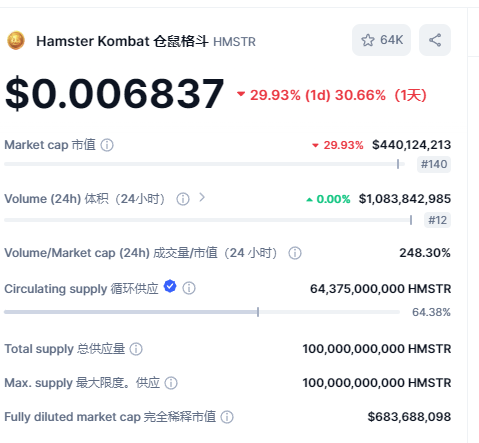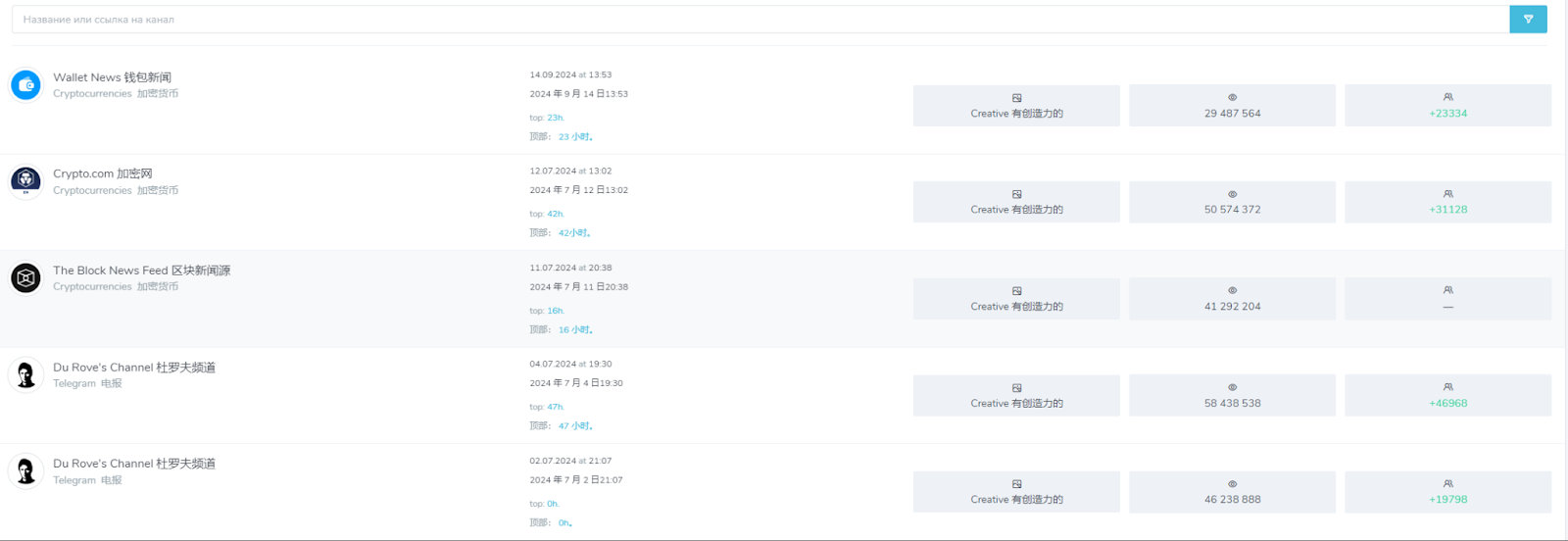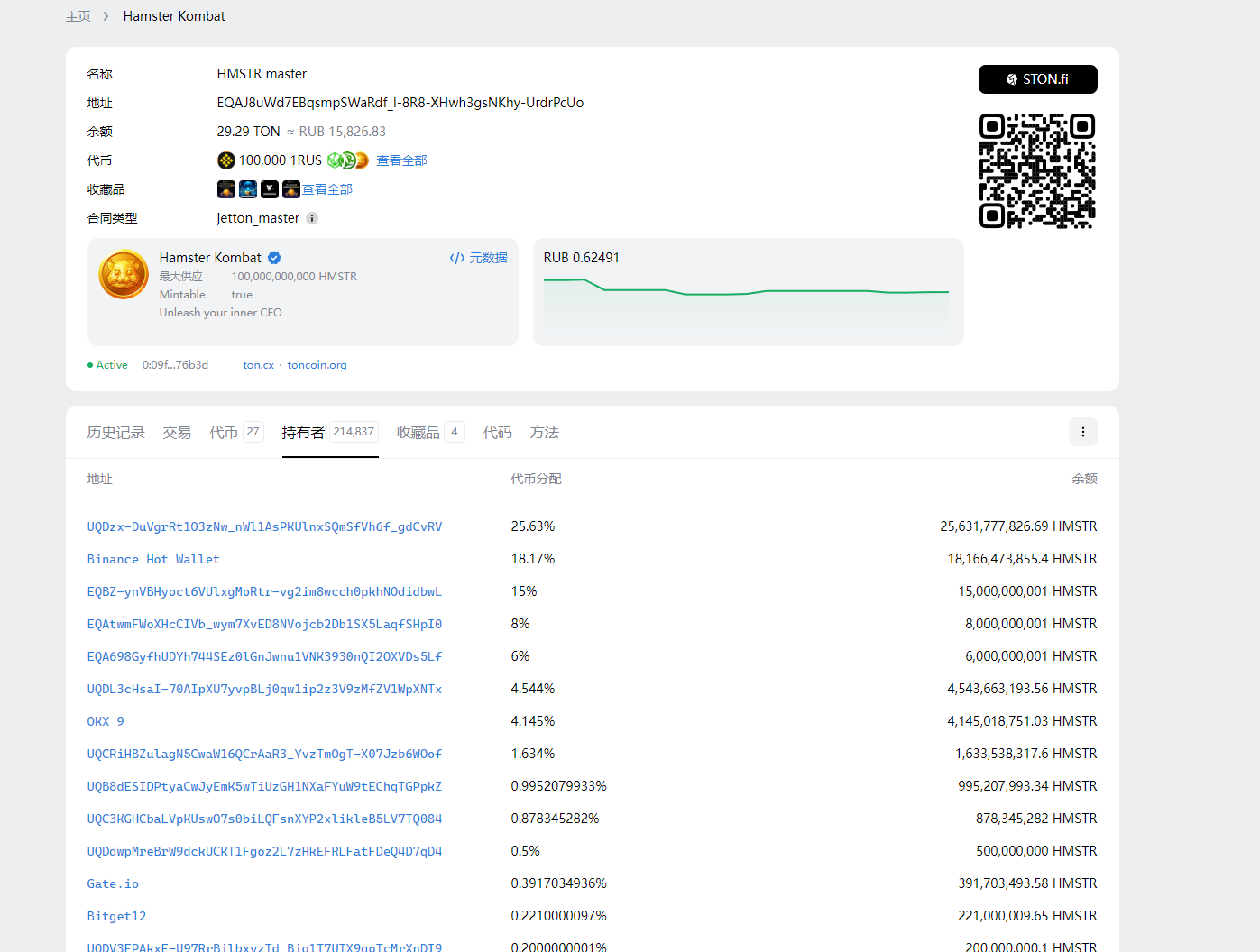Author: Frank, PANews
On September 26th, Hamster Kombat, a TON ecosystem clicker game boasting 300 million players, officially launched its airdrop, with its ecosystem token HMSTR being listed on over ten mainstream exchanges including Binance, OKEx, Bybit, Gate.io, and Bitget.
Hamster Kombat has created the largest airdrop user base to date, but like other large airdrops, it has been met with continuous community skepticism. Many users have reported that after months of clicking, they only received tokens worth $1, while circulated images show many obvious bots receiving a large number of tokens. Have hardworking users once again made a wedding dress for the project? And who are the real winners behind this airdrop feast involving hundreds of millions of users?
Average airdrop amount is only $3, "witch" rules are questioned
With the accumulation of a large number of users, distributing the airdrop has become the biggest challenge for Hamster Kombat. Previous large airdrops such as Jupiter and Zksync had user bases in the millions, with few experiences exceeding tens of millions. Especially for a project like Hamster Kombat, which did not have any anti-bot mechanism in the early stages, there were a large number of "fur farmers" participating. If the mechanism for identifying bots did not work, it would harm a large number of real users. According to the results, Hamster Kombat officially claimed a user base of 300 million, but the number of users eligible for the airdrop was 131 million, with approximately 2.3 million "witch" addresses identified.
The total supply of HMSTR tokens is 100 billion, and the airdrop ratio this time is 60%. Based on this calculation, the total airdrop amount is 60 billion tokens. Based on 130 million users, the average airdrop amount per user is approximately 458 tokens, which is equivalent to about $3.20 at a price of $0.007.
From the data, the market value of HMSTR is approximately $4.4 billion, which is lower than the initial $6.4 billion market value of DOGS and the $10 billion market value of NOT. This indicates that the market value of Hamster Kombat did not receive a higher premium due to its user base of over 100 million. Instead, due to the continuous delay of the airdrop and token listing, as well as the decreasing interest in similar products after the launch of multiple Ton ecosystem traffic products, the value of tokens received by each user is relatively low.
Naturally, the community has many complaints about such results. User @roe1527 complained on Twitter that they participated for 109 days, only to receive tokens worth about 17U in the end, which will be unlocked in batches. @roe1527 finally commented, "Maybe not caring much about this airdrop, but we should also respect the labor of the people. It's too dark, and the reputation will really stink."
After the airdrop rules were announced, PANews also wrote an article "Token Distribution Causes Controversy, Hamster Kombat, Once Popular with Fascia Gun, Offends Players", mentioning a player nicknamed Timbo, who claimed to have played the game almost from the beginning, playing the game for about 4-5 hours a day for two months, and earning about 500 tokens (only $3.5).
Project party, TON public chain, and exchanges emerge as the biggest winners?
In addition to users, the project party, exchanges, and the TON public chain are also the biggest winners of this largest airdrop.
From the perspective of the TON public chain, data shows that the number of addresses on the TON public chain has increased by 30 million since September, an increase of about 50%. The TON Foundation recently announced in its channel that the monthly active wallet count of TON has reached 10 million, reaching a historical high.
The ecological data of TON has shown an exponential increase mainly relying on the outbreak of multiple small games, with the number of addresses in early June being only 27 million. According to Binance's report, as of September 12th, the number of addresses linked to the TON wallet for Hamster Kombat was 55 million.

The large number of users may have also brought considerable advertising revenue to Hamster Kombat. Currently, Hamster Kombat has approximately 60 million subscribers on its Telegram channel, 37.6 million on its YouTube account, and 14.2 million Twitter followers. Such huge traffic represents monetizable assets on any platform. The official Telegram channel of Hamster Kombat started accepting advertising early on. Based on Telegram's CPM (cost per mille) being as low as 2 euros, with the recent Hamster Kombat ad views reaching 50 million, the income from this ad should be at least 100,000 euros. Not to mention that ads in the Hamster Kombat channel are pushed almost every day, and this income may reach tens of millions of dollars.

In addition to the project party and the TON ecosystem, this airdrop by Hamster Kombat has also triggered a large-scale exchange battle similar to the one before DOGS. Exchanges such as Binance, OKEx, HashKey Global, and Bitget have successively launched trading or airdrop activities for the HMSTR token. In this round of capital flow competition, Binance emerged as the biggest winner.
As of September 27th, Binance's share of HMSTR addresses accounted for approximately 18%, making it the highest among major exchanges, followed closely by Bybit, OKEx, and others. According to CMC's data, the trading volume of HMSTR in the past 24 hours exceeded $1 billion, ranking 12th among all tokens on the network, with Binance accounting for nearly half of the trading volume, becoming the largest market after the HMSTR airdrop. However, it is currently unknown how many new users Hamster Kombat has brought to the exchanges. Previously, Ben Zhou, the founder of Bybit, also predicted in an interview with Wu Shuo that the new user acquisition effect of Hamster might begin to decline. From the on-chain data, the number of addresses holding HMSTR tokens is only 214,000.

Looking back on the growth path, leveraging game playability and traffic diversion to rank first in global subscriptions
The success of Hamster Kombat is atypical. In March 2024, Hamster Kombat created a channel on Telegram and launched the game without any investment news or a prominent background. PANews was the first Chinese community media to report on the game, and when PANews noticed the game in May, there was almost no discussion on Twitter. At that time, driven by Notcoin, the TON ecosystem saw the emergence of multiple clicker games, and with the help of Notcoin's traffic diversion, Hamster Kombat was one of them. Other games that occupied the traffic trend at the same time as Hamster Kombat included Tapswap and Catizen.
In May, the number of users for Hamster Kombat was 15 million, although it was less than Tapswap (20 million users), its Telegram channel was already the third largest in the world. Over the next few months, Hamster Kombat claimed to have a user base of 300 million, and its Telegram channel currently has 69 million subscribers, ranking first globally.
Looking back on the reasons for Hamster Kombat's success, it may be mainly due to its excellent playability. Unlike other clicker games, Hamster Kombat, while also involving clicking to accumulate coins, changes its main gameplay to simulate investment games using in-game coins as the game progresses. Essentially, Hamster Kombat is a virtual management game with clicking as the entry point, making it more playable than several competing games.
Another reason for its rapid growth is the team's savvy traffic diversion tactics. Within the game mechanics of Hamster Kombat, they also introduced mechanisms to earn points through inviting friends and following social media accounts. The difference is that Hamster Kombat launched a daily news program, hiding large rewards passwords in these programs each day. Players need to watch videos or search for passwords in the comments section of social media. This not only rapidly increased the number of fans on Hamster Kombat's social media accounts but also gained a large number of real views, thereby receiving more recommendations from social media platform algorithms. These algorithm recommendations may have played a crucial role in the subsequent traffic monetization for Hamster Kombat.
Overall, the success of Hamster Kombat has opened up new ideas for many project parties. Instead of attracting users through high fundraising combined with airdrop gameplay, it lays the foundation for traffic through the playability of the game and the expected airdrop, and maximizes the traffic as monetizable assets (such as various social media accounts). However, compared to the previous airdrops that often resulted in thousands of dollars in income, this distribution method of having many users and little rewards is not recognized by the "fur farmers," and the airdrop feast may be gone for good.
免责声明:本文章仅代表作者个人观点,不代表本平台的立场和观点。本文章仅供信息分享,不构成对任何人的任何投资建议。用户与作者之间的任何争议,与本平台无关。如网页中刊载的文章或图片涉及侵权,请提供相关的权利证明和身份证明发送邮件到support@aicoin.com,本平台相关工作人员将会进行核查。




